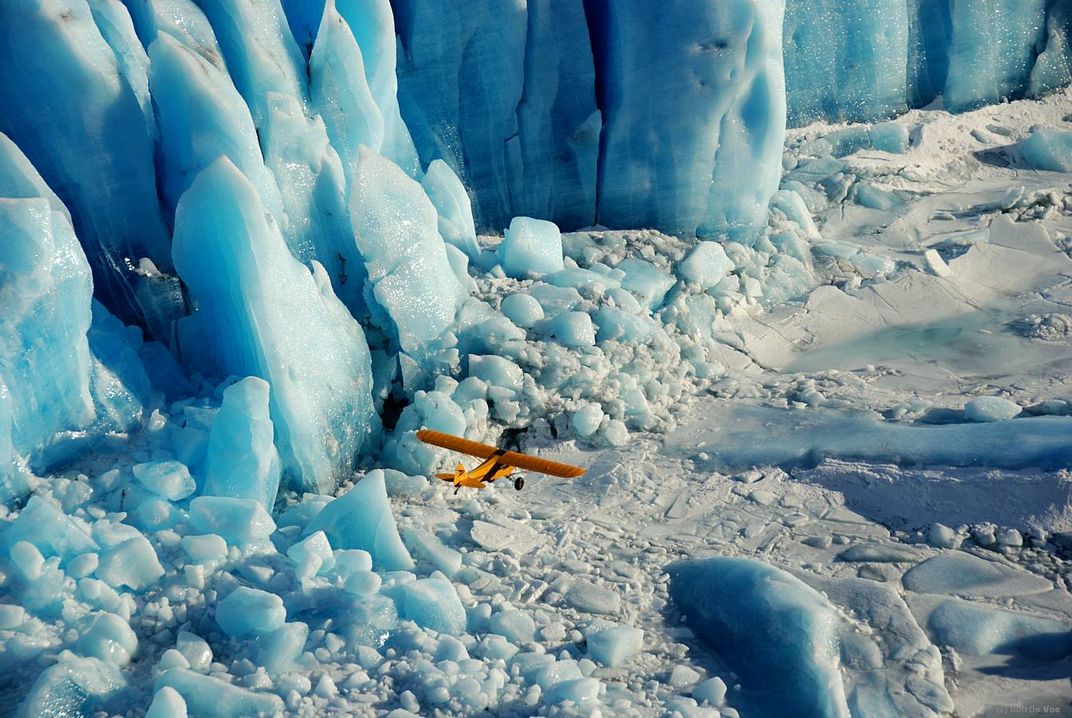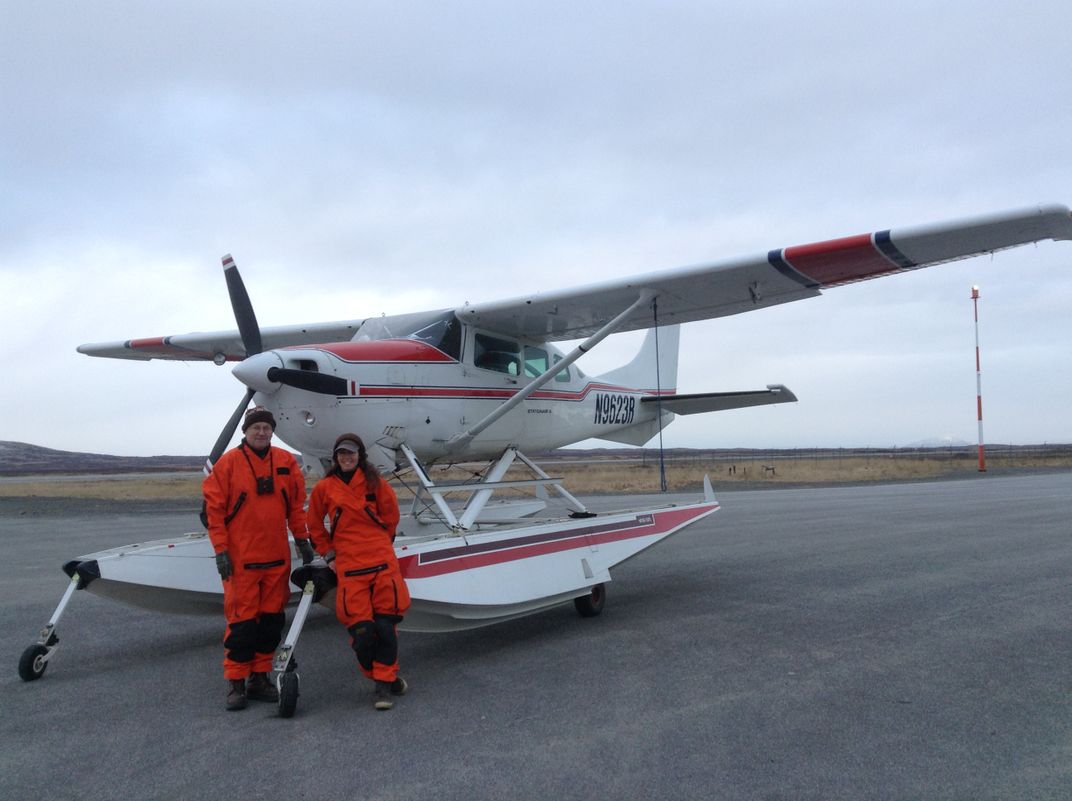This Biologist Defies Gravity (and Glass Ceilings) to Document the Effects of Climate Change
As one of five American women in this role, Heather Wilson blends aviation and birds to bolster climate change records
/https://tf-cmsv2-smithsonianmag-media.s3.amazonaws.com/filer/56/94/56944bf6-aa6a-4309-8aba-e7db1317b857/img_3167.jpg)
Flying low across the Alaskan threshold, Heather Wilson counts ducks. She swoops her Amphibious Cessna 206 plane over waterfowl breeding grounds, keeping her eyes peeled for their colorful plumage. Cruising at a constant 150’ and navigating around mountain ranges, along coastlines and across the Alaskan bush, Wilson is performing one of the most critical tasks necessary for monitoring waterfowl: aerial surveys.
These days it’s hard not to notice the vast changes taking over Alaska. In December 2016, temperatures soared to record highs, causing lakes to shrink, sea ice to erode and shrubs instead of lichen to spread across the tundra. The winter warm-up has been wreaking havoc on the ecosystems that support key native species like caribou, walruses and polar bears. “All Alaskans are seeing and feeling it,” says Wilson.
Unlike most Alaskans, though, Wilson has had a front row seat on this profound transformation. As a pilot-biologist for the U.S. Fish and Wildlife Service’s Division of Migratory Bird Management (FWS-DMBM), Wilson has been documenting the effects of climate change on birds in this change-prone region for nine years. “We see more subtle changes, like the advance of species northward and into areas we’ve never seen before: moose on the northern coastal fringes, previously ‘southern-only’ bird species showing up in the Arctic,” she says.
Being a pilot-biologist allows her to merge two longtime passions: aviation and birds. "The concept of flying the plane and being the biologist counting the animals out the window is not what most folks think of when they envision a pilot,” says Wilson, who is one of just five American women in this role. Wilson's current position is field project leader in Region 7, which covers all of Alaska; her route includes the Arctic Coastal Plain, the Yukon Delta and the Alaskan Peninsula.
Many of the surveys Wilson flies have been flown for decades. Having that wealth of historical data allows researchers to examine patterns that species and landscapes may be undergoing. For example, pilot-biologists discovered the wintering grounds of Spectacled eiders, an Arctic sea duck, after a swift decline based upon aerial survey data. Once scientists put satellite transmitters on a few nesting ducks , they were able to track own the entire population on several large polynyas, or areas of open water surrounded by ice, in the Bering Sea.

These kinds of waterfowl aerial surveys have been an integral part of wildlife management since they were initiated in the 1930s. However, the surveys weren’t consistently flown until 1947, following the end of World War II. That’s when FWS was able to hire military-trained pilots who already had wildlife or conservation experience as the first pilot-biologists. Now, with over 50 years of historical data, the waterfowl surveys help scientists understand how much has changed across the national landscape.
The state government also uses this data each year to determine hunting regulations and policies. Those regulations “are linked to the population status of each individual species,” says Julian Fischer, FWS-DMBM’s supervisory wildlife biologist for Region 7 and Wilson’s manager. Based upon the tallies in each "flyway," which is the ring of states that make up a migratory path of birds, each state then sets the number of birds of each species that hunters are allowed to harvest annually.
“It's not just population information that we're getting,” says Sarah Yates, a fellow pilot-biologist with FWS who befriended Wilson during a pilot training session in Maine years ago. “Because they are such longstanding surveys ... you can get information about climate change and how that might be affecting the distribution of waterfowl species. It's been huge in developing management programs for waterfowl.”
Climate cues are crucial to annual bird survival. “Temperature, snow melt and green up” all help predict when it’s time to nest, says Wilson. Without them, the probability of increased mortality among nestlings is likely. Birds with the longest migration will most likely feel these effects most. “Birds are highly mobile so they can take advantage of changing resources more easily than many other animals," she says, "but only to a certain extent.”
This weather shift has even altered when waterfowl surveys are conducted, since breeding season now begins earlier due to the birds’ earlier arrival to the breeding grounds. “Those species that are flexible enough to adjust their timing of migration to best match the timing of the landscape are showing up to breeding grounds well ahead of historic schedules,” says Wilson.
Fischer notes birds have adapted gradually and matched their breeding time to the changing climate. “Waterfowl typically initiate nest building as soon as their nesting habitat is clear of snow and ice,” he says, adding that this is also when plenty of food is available. “With an advance in nesting initiation date, it is reasonable to assume that the birds are responding to a changing climate.”
Positive news for now—but Wilson warns that the real danger lies in the future. “Population increases could lead to other problems, like increased competition among species or ecological traps if climate change results in more erratic, less predictable weather and habitat effects,” she says.

Wilson is now taking the lead of the mid-winter survey of Brant geese to document the increase in the over-wintering population and the overall increase of birds on northern nesting sites in general. While geese seem to be faring well so far under the shift in weather, this is one of the first species to show a population responding to climate change through the increased number of geese overwintering in Alaska. “We know that many of the Brant overwintering in Alaska are coming from Arctic-breeding colonies, where warming temperatures have resulted in increased habitat availability,” says Wilson.
For Wilson, being a pilot-biologist is “unbelievably satisfying.” But although she always had an interest in aviation and birds, she never realized the two could fit together until she met Russ Oates, a FWS-DMBM supervisor, while she was completing her PhD field work in Fairbanks, Alaska. “I always thought learning to fly was for someone who was rich or in the military,” says Wilson. Her conversations with Oates convinced her to try it out and, soon, she was hooked.
Still, the path wasn’t easy. To become a pilot-biologist with the FWS Migratory Bird Program, candidates must have a Bachelor’s degree in biological sciences or natural resources; most also have a Master’s or PhD. (Wilson has all three.) Pilot-biologists must also have a commercial pilot’s certificate with instrument flight privileges, which entails a minimum of 500 hours of flight time.
While she didn’t have flight experience before her move to Alaska for graduate school, Wilson had already obtained her pilot’s license and required flight hours by the time she met Oates, who then put her on any aerial survey he could, giving her a taste of what her future would become.
Wilson's path is similar to those of her fellow female pilot-biologists. Like Wilson, Kara Hilwig, a pilot-biologist for FWS’s Togiak National Wildlife Refuge in southwest Alaska, didn’t have flight experience prior to her interest in the job. Instead, she was drawn to the idea of Alaska’s wildness and spent time building up her flight hours after over 20 years in field biology.
It took her more than six years to gain enough flight experience to qualify for her current position. “This unique job becomes part of your personal identity,” says Hilwig. “You’re passionate about the biology, you’re passionate about the flying, you’re passionate about the learning.”
Wilson says that for her, her time in the air is more than just work. “Beyond being a scientist, I want to be able to tell my kids that we faced climate change head-on,” she says. “That we were strong enough to see it for what it was, and we tried our best to understand it, and do something about it."
/https://tf-cmsv2-smithsonianmag-media.s3.amazonaws.com/accounts/headshot/Kristen_A._Schmitt.jpg)
/https://tf-cmsv2-smithsonianmag-media.s3.amazonaws.com/accounts/headshot/Kristen_A._Schmitt.jpg)